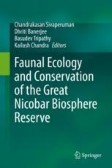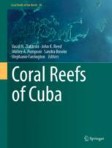Search
Search Results
-
Transcriptomic responses of Mediterranean sponges upon encounter with symbiont microbial consortia
BackgroundSponges (phylum Porifera) constantly interact with microbes. They graze on microbes from the water column by filter-feeding and they harbor...

-
Endogenous miRNA Sponges
MicroRNAs (miRNAs) are a class of noncoding RNAs of 17–22 nucleotides in length with a critical function in posttranscriptional gene regulation....
-
Sponges: Porifera
The phylum of sponges (Porifera) contains sessile organisms, most of which live in marine habitats. The few species of freshwaters all belong to the...
-
Importance of complex sponges as habitat and feeding substrata for coral reef fishes
Coral reef fishes are usually assumed to be most strongly associated with reef-building corals. However, sponges can be a significant structural...

-
Sponges and their prokaryotic communities sampled from a remote karst ecosystem
Marine karst ecosystems exist at the land-sea interface and are characterised by underwater formations sculpted over time by the action of seawater....

-
Genetic diversity studies of Baikal endemic sponges at the interspecies and population levels using high-resolution microsatellite markers
Lake Baikal, an ancient, massive lake in Siberia that holds 20% of the world’s fresh water reserves, is a unique center of speciation. Changes in the...

-
Species-specific relationships between deep sea sponges and their symbiotic Nitrosopumilaceae
Sponges thrive in the deep, dark and nutrient-depleted ocean and may rely on microbial symbionts for carbon acquisition and energy generation....

-
Marine Sponges of Great Nicobar Biosphere Reserve
Marine sponges of Great Nicobar Island are among the least studied marine faunal groups. The present study is intended to review the published...
-
Metallic trace elements in marine sponges living in a semi-enclosed tropical lagoon
The ability of marine filter feeders to accumulate metals could help monitor the health of the marine environment. This study examined the...

-
Isolation of Actinobacteria from Sponges
Amidst plethora of marine microbes, actinobacteria, the prolific antibiotic producers, play a very substantial role. Being active endosymbionts of...
-
Substratum selection in coral reef sponges and their interactions with other benthic organisms
Substratum preferences and contact interactions among sessile organisms can be a major determinant of biotic gradients in the structure of benthic...

-
An Outlook on Marine Sponges and Associated Biodiversity Addressing Conservation Strategies
Sponges are the pore-bearing animals belonging to the phylum Porifera. They are the oldest living multicellular invertebrates on this planet. Sponges...
-
Microbiome diversity and metabolic capacity determines the trophic ecology of the holobiont in Caribbean sponges
Sponges are increasingly recognized as an ecologically important taxon on coral reefs, representing significant biomass and biodiversity where...

-
First observations of Weddell seals foraging in sponges in Erebus Bay, Antarctica
Attaching cameras to marine mammals allows for first-hand observation of underwater behaviours that may otherwise go unseen. While studying the...

-
High microbiome and metabolome diversification in coexisting sponges with different bio-ecological traits
Marine Porifera host diverse microbial communities, which influence host metabolism and fitness. However, functional relationships between sponge...

-
Terpenes extracted from marine sponges with antioxidant activity: a systematic review
Marine biodiversity has emerged as a very promising resource of bioactive compounds and secondary metabolites from different sea organisms. The...

-
Catalindoles A–C: brominated indole alkaloids from the starfish Thromidia catalai, which feeds on Theonella sponges
Marine sponges harbor diverse secondary metabolites with a variety of biological activity, many of which are considered as chemical defense...

-
Sponges (Porifera) from the Ross Sea (Southern Ocean) with taxonomic and molecular re-description of two uncommon species
Porifera are one of the dominant components of the marine benthic communities in the Antarctic Sea (44% of the total species are endemic). Despite...

-
A carbon cycling model shows strong control of seasonality and importance of sponges on the functioning of a northern Red Sea coral reef
Coral reefs in the northern Red Sea experience strong seasonality. This affects reef carbon (C) cycling, but ecosystem-wide quantification of C...

-
Sponges: Conspicuous Inhabitants of the Cuban Coral Reefs and Their Potential as Bioindicators of Contamination
Sponges are a key component of coral reefs due to their high biodiversity and multiple ecological functions. We analyzed the current knowledge of...
